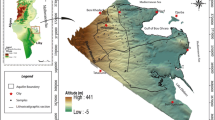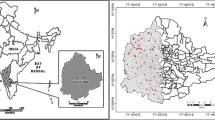Abstract
This research investigated the quality of groundwater of 298 wells during 10 years, in Fars province, southern Iran, to survey spatial variation of groundwater quality and also major sources of hydro-chemical components for drinking and agricultural uses. To classify the sampling stations in each year, hierarchical cluster analysis, using the Euclidean distances and “Ward” method, was used. According to the results of cluster analysis, there were three quality groups in groundwater of the research area: first group of 170 wells with type of Ca-HCO3, second group of 98 wells with type of Ca-HCO3, and third group of 30 wells with type of Na-Cl. Hydro-chemical parameters were increased from the first to the third group, and on the basis of Schoeller and USSL diagrams, the water of wells of the third group was considered unsuitable for irrigation and drinking. Principal component (PC) analysis and factor analysis reduced the complex and voluminous data matrix into three main components, accounting for more than 80 % of the total variance. The first PC contained TDS, EC, TH, Na+, Cl−, Mg2+, SO4 2−, Ca2+, and SAR parameters. Therefore, the first dominant factor was salinity. In PC2, HCO3 and pH were the dominant parameters, which may indicate weathering of silicate minerals. The PC3 contained high loadings for NO2 2− and NO3 −. This factor indicates anthropogenic contaminants that may be caused by improper disposal of domestic wastes or the use of chemical fertilizers in agriculture and leaching of them.








Similar content being viewed by others
Notes
Food and Agricultural Organization
World Health Organization
References
APHA, WEF. (2005). Standard methods for the examination of water and wastewater (21st ed.). USA: American Public Health Association/American Water Works Association/Water Environment Federation.
Ayers, R. S., & Westcot, D. W. (1985). Water quality for agriculture (Vol. 29). Rome: FAO.
Bencer, S., Boudoukha, A., & Mouni, L. (2016). Multivariate statistical analysis of the groundwater of Ain Djacer area (Eastern of Algeria). Arabian Journal of Geosciences, 9(4), 1–10. doi:10.1007/s12517-015-2277-6.
Chen, K., Jiao, J. J., Huang, J., & Huang, R. (2007). Multivariate statistical evaluation of trace elements in groundwater in a coastal area in Shenzhen, China. Environmental Pollution, 147, 771–780.
Daughney, C. J., Raiber, M., Moreau-Fournier, M., Morgenstern, U., & van der Raaij, R. (2012). Use of hierarchical cluster analysis to assess the representativeness of a baseline groundwater quality monitoring network: comparison of New Zealand’s national and regional groundwater monitoring programs. Hydrogeology Journal, 20(1), 185–200.
Freeze, R. A., & Cherry, J. A. (1979). Groundwater (p. 604). New-jersey: Prentice-Hall, inc.
Gupta, I., Dhage, S., & Kumar, R. (2009). Study of variations in water quality of Mumbai coast through multivariate analysis techniques. Indian Journal of Marine Sciences, 38(2), 170–177.
Hem, J. D. (1985). Study and interpretation of the chemical characteristics of natural water (Vol. 2254). US Geological Survey: Department of the Interior.
Hojjati, M. H., & Boustani, F. (2010). An assessment of groundwater crisis in Iran, case study: Fars province. World Academy of Science, Engineering and Technology, 70, 476–480.
Jalali, M. (2007). Hydrochemical identification of groundwater resources and their changes under the impacts of human activity in the Chah basin in western Iran. Environmental Monitoring and Assessment, 130(1–3), 347–364.
Jalali, M. (2010). Groundwater geochemistry in the Alisadr, Hamadan, western Iran. Environmental Monitoring and Assessment, 166(1–4), 359–369.
Kaiser, H. F. (1960). The application of electronic computers to factor analysis. Educational and Psychological Measurement, 20, 141–151.
Kim, J. H., Kim, R. H., Lee, J., Cheong, T. J., Yum, B. W., & Chang, H. W. (2005). Multivariate statistical analysis to identify the major factors governing groundwater quality in the coastal area of Kimje, South Korea. Hydrological Processes, 19(6), 1261–1276. doi:10.1002/hyp.5565.
Kraiem, Z., Zouari, K., Chkir, N., & Agoune, A. (2014). Geochemical characteristics of arid shallow aquifers in Chott Djerid, south-western Tunisia. Journal of Hydro-Environment Research, 8(4), 460–473.
Lambrakis, N., Voudouris, K., Tiniakos, L., & Kallergis, G. (1997). Impacts of simultaneous action of drought and overpumping on Quaternary aquifers of Glafkos basin (Patras region, western Greece). Environmental Geology, 29(3–4), 209–215.
Lix, L. M., Keselman, J. C., & Keselman, H. (1996). Consequences of assumption violations revisited: a quantitative review of alternatives to the one-way analysis of variance F test. Review of Educational Research, 66(4), 579–619.
Machiwal, D., & Singh, P. K. (2015). Understanding factors influencing groundwater levels in hard-rock aquifer systems by using multivariate statistical techniques. Environmental Earth Sciences, 74(7), 5639–5652.
Masoud, A. A. (2013). Spatio temporal evaluation of the groundwater quality in Kafr Al-Zayat District, Egypt. Hydrological Processes, 27(20), 2987–3002.
McNeil, V. H., Cox, M. E., & Preda, M. (2005). Assessment of chemical water types and their spatial variation using multi-stage cluster analysis, Queensland, Australia. Journal of Hydrology, 310(1), 181–200. doi:10.1016/j.jhydrol.2004.12.014.
Metcalf, L., & Eddy, H. (2003). Wastewater engineering, treatment and reuse (4th ed.). New York: Tata McGraw-Hill Co.
Miller, T. L., & Gonthier, J. B. (1984). Oregon ground-water quality and its relation to hydrogeologic factors: a statistical approach (Vol. 84). USA: US Geological Survey.
Mohebbi, M. R., Saeedi, R., Montazeri, A., Vaghefi, K. A., Labbafi, S., Oktaie, S., Abtahi, M., & Mohagheghian, A. (2013). Assessment of water quality in groundwater resources of Iran using a modified drinking water quality index (DWQI). Ecological Indicators, 30, 28–34.
Olajire, A. A., & Imeokparia, F. E. (2001). Water quality assessment of Osun river: studies on inorganic nutrients. Environmental Monitoring and Assessment, 69(1), 17–28.
Organization, W. H. (1993). Guidelines for drinking water quality (2nd ed. Vol. 1). Geneva: World Health Organization.
Ostovari, Y., Beigi-Harchegani, H., & Asgari, K. (2015). A fuzzy logic approach for assessment and mapping of groundwater irrigation quality: a case study of Marvdasht aquifer, Iran. Archives of Agronomy and Soil Science, 61(5), 711–723.
Panno, S., Hackley, K., Hwang, H., Greenberg, S., Krapac, I., Landsberger, S., & O’Kelly, D. (2006). Characterization and identification of Na‐Cl sources in ground water. Groundwater, 44(2), 176–187. doi:10.1111/j.1745-6584.
Raju, N. J., Patel, P., Gurung, D., Ram, P., Gossel, W., & Wycisk, P. (2015). Geochemical assessment of groundwater quality in the Dun valley of central Nepal using chemometric method and geochemical modeling. Groundwater for Sustainable Development, 1(1), 135–145.
Razmkhah, H., Abrishamchi, A., & Torkian, A. (2010). Evaluation of spatial and temporal variation in water quality by pattern recognition techniques: a case study on Jajrood River (Tehran, Iran). Journal of Environmental Management, 91(4), 852–860.
Richards, L. (1954). Diagnosis and Improvement of saline and alkali soils. USDA handbook no. 60, US Govt (Vol. 160).
Schoeller, H. (1962). Les eaux souterraines (p. 642). Paris: Masson & Cie.
Shapiro, S. S., & Wilk, M. B. (1965). An analysis of variance test for normality (complete samples). Biometrika, 52(3), 591–611.
Shrestha, S., & Kazama, F. (2007). Assessment of surface water quality using multivariate statistical techniques: a case study of the Fuji river basin, Japan. Environmental Modelling & Software, 22(4), 464–475.
Stiff, H. A., Jr. (1951). The interpretation of chemical water analysis by means of patterns. Journal of Petroleum Technology, 3(10), 15–13.
Twarakavi, N. K., & Kaluarachchi, J. J. (2006). Sustainability of ground water quality considering land use changes and public health risks. Journal of Environmental Management, 81(4), 405–419. doi:10.1016/j.jenvman.
Wenning, R. J., & Erickson, G. A. (1994). Interpretation and analysis of complex environmental data using chemometric methods. Trends in Analytical, 13, 446–457.
Yerel, S. (2010). Water quality assessment of Porsuk River, Turkey. Journal of Chemistry, 7(2), 593–599.
Yidana, S. M. (2010a). Groundwater classification using multivariate statistical methods: Birimian Basin, Ghana. Journal of Environmental Engineering, 136(12), 1379–1388.
Yidana, S. M. (2010b). Groundwater classification using multivariate statistical methods: Southern Ghana. Journal of African Earth Sciences, 57(5), 455–469. doi:10.1016/j.jafrearsci.2009.12.002.
Author information
Authors and Affiliations
Corresponding author
Rights and permissions
About this article
Cite this article
Noshadi, M., Ghafourian, A. Groundwater quality analysis using multivariate statistical techniques (case study: Fars province, Iran). Environ Monit Assess 188, 419 (2016). https://doi.org/10.1007/s10661-016-5412-2
Received:
Accepted:
Published:
DOI: https://doi.org/10.1007/s10661-016-5412-2




